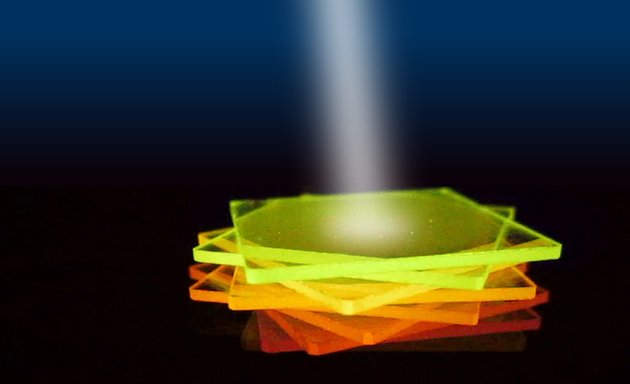A group of physicists and chemists from TU Dresden recently presented an organic thin-film sensor to explain a very new method of determining the wavelength of light and reaching a spectral resolution of one nanometer. The research was presented in the journal Advanced Materials.

The active film for the novel sensor concept is only as thick as human hair, here processed on thin glass substrates, and exhibits a wavelength-dependent luminescence. Image Credit: TU Dresden
Thin-film sensors may one day replace the requirement for external spectrometers as they are integrated components. The innovative technology has already been the subject of a patent application.
A collection of experimental techniques called spectroscopy separates radiation into components based on a particular characteristic, such as wavelength or mass.
Spectrometers are employed as sensors in a variety of fields, including medical, engineering, the food industry, and numerous others.
They can identify the colors (wavelengths) of light sources. Instruments that are for sale commercially are typically huge and very costly. Most of them are built on the prism or grating principle, which states that light is refracted and that the wavelength is determined by the angle of refraction.
These sensor components based on organic semiconductors have been studied for years at the Institute for Applied Physics (IAP) and the Dresden Integrated Center for Applied Physics and Photonic Materials (IAPP) at TU Dresden. Two systems have already been brought toward market maturity with the spin-offs Senorics and PRUUVE.
Presently, scientists at the IAP and IAPP have created a thin-film sensor that explains an entirely new method of determining the wavelength of light and has significant advantages over available commercial spectrometers due to its small size and low cost. This sensor was created in collaboration with the Institute of Physical Chemistry.
The innovative sensors work on the following principle: A thin coating of luminous materials is excited by an unidentified wavelength of light.
Long-glow (phosphorescent) and short-glow (fluorescent) entities coexist in the film, each of which absorbs the light under study in a different manner. The wavelength of the unidentified input light can be deduced from the afterglow’s intensity.
We exploit the fundamental physics of excited states in luminescent materials. Light of different wavelengths excites in such a system, and when properly composed, certain proportions of long-lived triplet and short-lived singlet spin states. In addition, we reverse that dependence. By identifying the spin fractions using a photodetector, we can identify light wavelengths.
Anton Kirch, Doctoral Student, Institute for Applied Physics, TU Dresden
“The great strength of our research alliance here in Dresden is our partners. Together with the groups of Prof. Alexander Eychmüller from Physical Chemistry and Karl Leo, professor of Optoelectronics, we can carry out all the fabrication and analysis steps ourselves, starting with material synthesis and film processing and ending with the fabrication of the organic detector,” says Prof. Sebastian Reineke, who coordinated the project.
Dr. Johannes Benduhn, a group leader for Organic Sensors and Solar Cells at the IAP said, “I was honestly very impressed that a simple photoactive film combined with a photodetector can form such a high-resolution device.”
By employing this method, the researchers have successfully tracked minute wavelength changes in light sources and attained sub-nanometer spectral resolution.
The innovative sensors can be employed in counterfeit protection in addition to characterizing light sources: “The small and inexpensive sensors could be used, for example, to quickly and reliably check banknotes or documents for certain security features and thus determine their authenticity, without any need for expensive laboratory technology,” explains Anton Kirch.
Journal Reference
Kirch, A., et al. (2022) Accurate Wavelength Tracking by Exciton Spin Mixing. Advanced Materials. https://onlinelibrary.wiley.com/doi/10.1002/adma.202205015